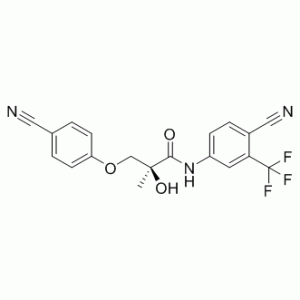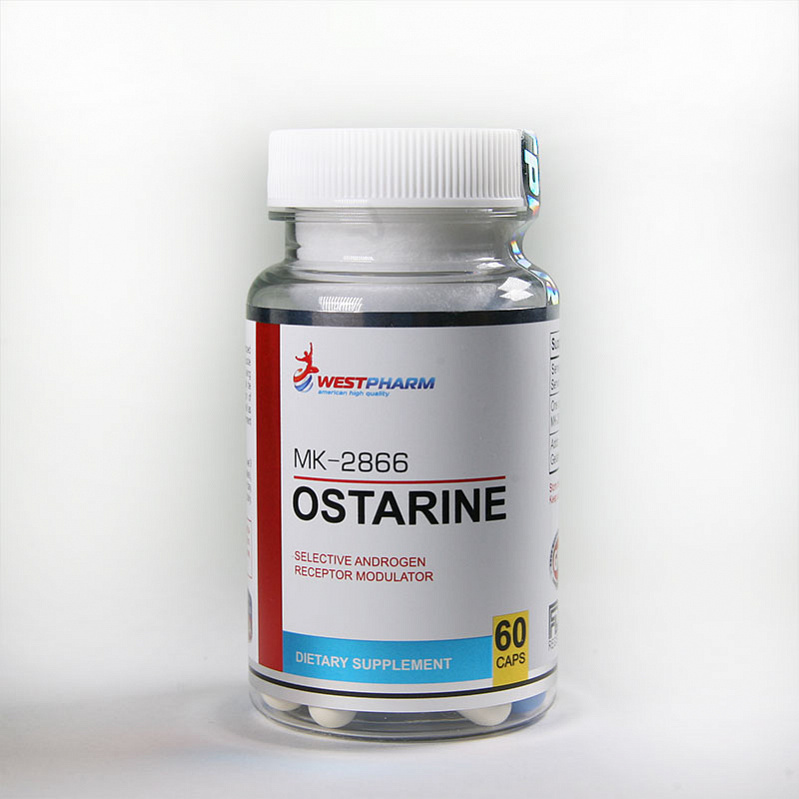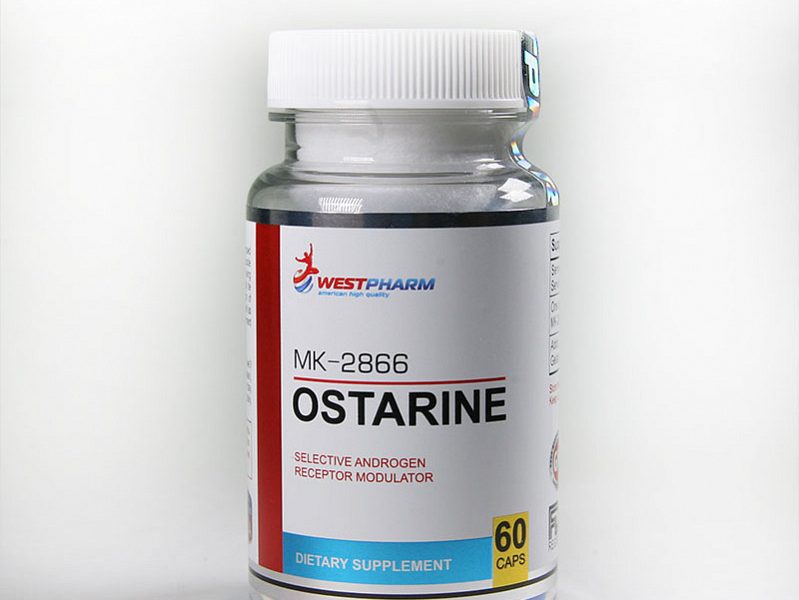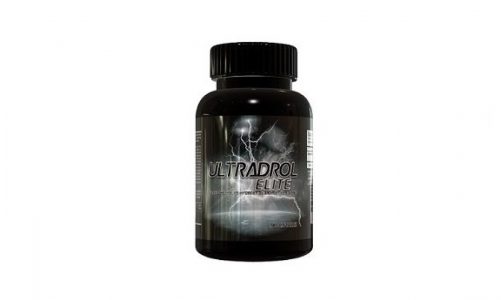
ENOBOSARM (2S) -3- (4-cyanophenoxy) -N- [4-cyano-3- (trifluoromethyl) phenyl] -2-hydroxy-2-methylpropanamide , commonly known as OSTARINA or also as GTx-024 or MK-2866 , is a SARM (Selective Androgen Receptor Modulator), SARM – These are anabolic androgenic drugs that differentiate receptor affinity based on the tissue location of androgen receptors. Strictly speaking, any AAS with a therapeutic index above 1 can be considered a SARM, but this name is usually reserved for a new generation of anabolic molecules developed independently of the structure of testosterone and cholesterol themselves: in fact, they do not belong to the steroid genus.
Amarin is currently the only SARM that has demonstrated an almost complete dissociation between androgenic and anabolic effects, demonstrating a marked and exceptional affinity for androgen receptors in muscle and bone tissue and, to a lesser extent, for adipose tissue (lipolytic effect). In the clinical experimental phase, it showed no affinity for the receptors of the prostate, clitoris, hair follicles, vocal cords and internal glands. In clinical trials (conducted, however, at no more than 3 mg per day), male hormonal parameters remain practically unchanged, with the exception of a decrease in total testosterone, which, however, is compensated by a decrease in SHBG, which completely restores free testosterone values. The hemolipid values remain practically unchanged, with the exception of a slight decrease in HDL, which is compensated by a decrease in total cholesterol. There is no aromatization (despite rumors of it in various American forums) and the product is completely orally bioavailable, without any liver toxicity. The athletic community has also empirically observed a complete dissociation between androgenic and anabolic effects: at least up to a dose of 25 mg per day, athletes rarely report cycle changes; some do not have significant suppression of the gonads up to 50-60 mg, with 40 mg, athletes usually report dysmenorrhea, but not amenorrhea, at least in the first months of admission. Also in athletes I have found that typical androgenic effects are not reported even at 60 mg per day.
The anabolic properties of mg per mg ostarine are remarkable to say the least: compared to methyl testosterone (110 androgen / 130 anabolic versus testosterone) of 100, the first estimates of androgenic effect are around 1.the estimates of anabolic strength are still unclear since the classical assessment is based on dissection of the prostate and muscles of the levator and rats; but from direct experience that I could see, I would say that we are about 2-3 times more anabolic than methyl testosterone, up to a dose of 20-25 mg per day: after this dose, the anabolic strength of mg per mg decreases rapidly so that you do not have anabolic benefits beyond the 40 mg daily dose.

ENOBOSARM (2S) -3- (4-cyanophenoxy) -N- [4-cyano-3- (trifluoromethyl) phenyl] -2-hydroxy-2-methylpropanamide , commonly known as OSTARINA or also as GTx-024 or MK-2866 , is a SARM (Selective Androgen Receptor Modulator), SARM – These are anabolic androgenic drugs that differentiate receptor affinity based on the tissue location of androgen receptors. Strictly speaking, any AAS with a therapeutic index above 1 can be considered a SARM, but this name is usually reserved for a new generation of anabolic molecules, developed independently of the structure of testosterone and cholesterol itself: in fact, they do not belong to the steroid genus.
Amarin is currently the only SARM that has demonstrated an almost complete dissociation between androgenic and anabolic effects, demonstrating a marked and exceptional affinity for androgen receptors in muscle and bone tissue and, to a lesser extent, for adipose tissue (lipolytic effect). In the clinical experimental phase, it showed no affinity for the receptors of the prostate, clitoris, hair follicles, vocal cords and internal glands. In clinical trials (conducted, however, at no more than 3 mg per day), male hormonal parameters remain practically unchanged, with the exception of a decrease in total testosterone, which, however, is compensated by a decrease in SHBG, which completely restores free testosterone values. The hemolipid values remain virtually unchanged, with the exception of a slight decrease in HDL, which is offset by a decrease in total cholesterol., There is no aromatization (despite rumors about it in various American forums), and the product is completely bioavailable orally, without any liver toxicity. The athletic community has also empirically observed a complete dissociation between androgenic and anabolic effects: at least up to a dose of 25 mg per day, athletes rarely report cycle changes; some do not have significant suppression of the gonads up to 50-60 mg, with 40 mg, athletes usually report dysmenorrhea, but not amenorrhea, at least in the first months of admission. Also in athletes I have found that typical androgenic effects are not reported even at 60 mg per day.
The anabolic properties of mg per mg ostarine are remarkable to say the least: compared to methyl testosterone (110 androgen / 130 anabolic versus testosterone) of 100, the first estimates of androgenic effect are around 1.the estimates of anabolic strength are still unclear since the classical assessment is based on dissection of the prostate and muscles of the levator and rats; but from direct experience that I could see, I would say that we are about 2-3 times more anabolic than methyl testosterone, up to a dose of 20-25 mg per day: after this dose, the anabolic strength of mg per mg decreases rapidly so that you do not have anabolic benefits beyond the 40 mg daily dose.

ENOBOSARM (2S) -3- (4-cyanophenoxy) -N- [4-cyano-3- (trifluoromethyl) phenyl] -2-hydroxy-2-methylpropanamide , commonly known as OSTARINA or also as GTx-024 or MK-2866 , is a SARM (Selective Androgen Receptor Modulator), SARM – These are anabolic androgenic drugs that differentiate receptor affinity based on the tissue location of androgen receptors. Strictly speaking, any AAS with a therapeutic index above 1 can be considered a SARM, but this name is usually reserved for a new generation of anabolic molecules developed independently of the structure of testosterone and cholesterol themselves: in fact, they do not belong to the steroid genus.
Amarin is currently the only SARM that has demonstrated an almost complete dissociation between androgenic and anabolic effects, demonstrating a marked and exceptional affinity for androgen receptors in muscle and bone tissue and, to a lesser extent, for adipose tissue (lipolytic effect). In the clinical experimental phase, it showed no affinity for the receptors of the prostate, clitoris, hair follicles, vocal cords and internal glands. In clinical trials (conducted, however, at no more than 3 mg per day), male hormonal parameters remain practically unchanged, with the exception of a decrease in total testosterone, which, however, is compensated by a decrease in SHBG, which completely restores free testosterone values. The hemolipid values remain practically unchanged, with the exception of a slight decrease in HDL, which is compensated by a decrease in total cholesterol. There is no aromatization (despite rumors about it in various American forums) and the product is completely bioavailable orally, without any liver toxicity… The athletic community has also empirically observed a complete dissociation between androgenic and anabolic effects: at least up to a dose of 25 mg per day, athletes rarely report cycle changes; some do not have significant suppression of the gonads up to 50-60 mg, with 40 mg, athletes usually report dysmenorrhea, but not amenorrhea, at least in the first months of admission. Also in athletes I have found that typical androgenic effects are not reported even at 60 mg per day.
The anabolic properties of mg per mg ostarine are remarkable to say the least: compared to methyl testosterone (110 androgen / 130 anabolic versus testosterone) of 100, the first estimates of androgenic effect are around 1.the estimates of anabolic strength are still unclear since the classical assessment is based on dissection of the prostate and muscles of the levator and rats; but from direct experience that I could see, I would say that we are about 2-3 times more anabolic than methyl testosterone, up to a dose of 20-25 mg per day: after this dose, the anabolic strength of mg per mg decreases rapidly so that you do not have anabolic benefits beyond the 40 mg daily dose.

ENOBOSARM (2S) -3- (4-cyanophenoxy) -N- [4-cyano-3- (trifluoromethyl) phenyl] -2-hydroxy-2-methylpropanamide , commonly known as OSTARINA or also as GTx-024 or MK-2866 , is a SARM (Selective Androgen Receptor Modulator), SARM – These are anabolic androgenic drugs that differentiate receptor affinity based on the tissue location of androgen receptors. Strictly speaking, any AAS with a therapeutic index above 1 can be considered a SARM, but this name is usually reserved for a new generation of anabolic molecules, developed independently of the structure of testosterone and cholesterol itself: in fact, they do not belong to the steroid genus.
Amarin is currently the only SARM that has demonstrated an almost complete dissociation between androgenic and anabolic effects, demonstrating a marked and exceptional affinity for androgen receptors in muscle and bone tissue and, to a lesser extent, for adipose tissue (lipolytic effect). In the clinical experimental phase, it showed no affinity for the receptors of the prostate, clitoris, hair follicles, vocal cords and internal glands. In clinical trials (conducted, however, at no more than 3 mg per day), male hormonal parameters remain practically unchanged, with the exception of a decrease in total testosterone, which, however, is compensated by a decrease in SHBG, which completely restores free testosterone values. The hemolipid values remain virtually unchanged, with the exception of a slight decrease in HDL, which is offset by a decrease in total cholesterol., There is no aromatization (despite rumors about it in various American forums), and the product is completely bioavailable orally, without any liver toxicity. The athletic community has also empirically observed a complete dissociation between androgenic and anabolic effects: at least up to a dose of 25 mg per day, athletes rarely report cycle changes; some do not have significant suppression of the gonads up to 50-60 mg, with 40 mg, athletes usually report dysmenorrhea, but not amenorrhea, at least in the first months of admission. Also in athletes I have found that typical androgenic effects are not reported even at 60 mg per day.
The anabolic properties of mg per mg ostarine are at least remarkable: compared with methyl testosterone (110 androgen / 130 anabolic versus testosterone) of 100, the first estimates of androgenic effect are around 1… estimates of anabolic strength are still unclear, as the classical estimate is based on dissection of the prostate and muscles of the levator and rats; but from direct experience that I could see, I would say that we are about 2-3 times more anabolic than methyl testosterone, up to a dose of 20-25 mg per day: after this dose, the anabolic strength of mg per mg decreases rapidly so that you do not have anabolic benefits beyond the 40 mg daily dose.
This molecule has also shown remarkable anti-estrogenic activity (it was developed for the prevention and treatment of breast cancer, like many highly effective AAS that are now out of use): in clinical trials, it has shown the ability to suppress estrogens by only 47%. 3 mg daily; many athletes find aromatization to be nearly zero at 40 mg per day. This greatly alleviates muscle damage, given the protective effect of estrogen on muscle tissue. These anti-estrogenic characteristics limit the proliferation of androgen receptors that stararin craves (a bit like trenbolone). Coadministration of aromatized anabolic steroids has proven ineffective to compensate for this problem, since, apparently, the stararin strongly binds to the aromatase enzyme, which thus absorbs some of its activity. Co-administration of aromatasehemmer kaufen alleviates the problem of lower anabolic activity in the presence of aromatizers, but not the problem of hunger for androgen receptors, in addition to a decrease in libido. We should expect the best results in terms of volume to come from this single association: OSTARINA + ANTIAROMATASE + ESTRADIOLO. To this combination can be added non-aromatic, but non-aromatic anabolic agents (such as oxandrolone or winstrol); in particular, they have been found to be particularly strong in association with ostarine and oxandrolone… While high doses of AR anabolic steroids are contraindicated, since ostarine competes significantly for muscle androgen receptors (but there is still no “official” comparison with metribolone): in fact, nonar, when associated with ostarine, becomes clearly more androgenic. Metribolone (apart from hepatotoxicity) will be indicated, since it is probably more similar to the osteomuscular AR of the same ostarine and is very effective at very low dosages. In addition, methyltrenbolone has an affinity for corticosteroid receptors, which ostarin will lack, as well as for androgen receptors in adipose tissue, on which ostarine is less active.
Another typical feature of Osstarine is its now renowned slowness to “grip”: 1 to 3 weeks to full effect; There are several explanations for this phenomenon, which may overlap:
- the anabolic strength of the product may be due to the exceptional stability of the connection with osteomuscular androgen receptors or the long-term maintenance of the signal transmitted by RNA to the cell nucleus
- non-genomic affinity is absent, anabolic appears most rapidly
- some of the product, as we have seen, goes into aromatase inhibition before saturation of estrogen receptors (for which ostarine apparently has an affinity) allows the remaining ostarine to devote itself to the androgen-muscle connection.
Overall, Osstarin-Enobosarm appears to be an extremely potent and versatile molecule used both in volumetric and cutaway but also to prevent virilizing or antigonadal action… With this molecule, the border between the bridge and the PCT effectively disappears, since during its use it is possible to restore good HPTA functionality (if the cycle was only moderately antigonadal), as for all PCTs with conventional protective agents (antiestrogens and possibly gonadropins or the like) and , at the same time, significantly support muscle mass.

But the most promising feature of stararin is the possibility of widespread use by the mass of the population to improve the quality of life and strengthen the immune system, which leads to the prevention of many diseases, including cancer. But this is already the misfortune of AAS.Probably, the ability of the stararin (or other sarms that can be improved in the future) to increase the efficiency of the immune system and improve body composition without side effects will not be enough for mass diffusion: the profit of the pharmaceutical industry from disease, not from public health … It is no coincidence that Osstarine is available in the US as a dietary supplement (for mice for gymnastics), but as a drug it remains excluded from therapeutic use by the mass of the population, as for almost 20 years it was considered “experimental” … perhaps the longest trial in the history of pharmacology.
Another typical feature of Osstarine is its now renowned slowness to “grip”: 1 to 3 weeks to full effect; There are several explanations for this phenomenon, which may overlap:
- the anabolic strength of the product may be due to the exceptional stability of the connection with osteomuscular androgen receptors or the long-term maintenance of the signal transmitted by RNA to the cell nucleus
- non-genomic affinity is absent, anabolic appears most rapidly
- some of the product, as we have seen, goes into aromatase inhibition before saturation of estrogen receptors (for which ostarine apparently has an affinity) allows the remaining ostarine to devote itself to the androgen-muscle connection.
Overall, Osstarin-Enobosarm appears to be an extremely potent and versatile molecule that can be used both naturally and in cut, but also to prevent virilizing or antigonadal effects. With this molecule, the border between the bridge and the PCT effectively disappears, since during its use it is possible to restore good HPTA functionality (if the cycle was only moderately antigonadal), as for all PCTs with conventional protective agents (antiestrogens and possibly gonadropins or the like) and , at the same time, significantly support muscle mass.
But the most promising feature of stararin is the possibility of widespread use by the mass of the population to improve the quality of life and strengthen the immune system, which leads to the prevention of many diseases, including cancer. But this is the misfortune of the AAS. It is likely that the ability of stararin (or other sarms that could be improved in the future) to increase the efficiency of the immune system and improve body composition without side effects will not be enough for mass diffusion: the pharmaceutical industry’s profits from disease, not public health… It is no coincidence that Osstarine is available in the US as a dietary supplement (for mice for gymnastics), but as a drug it remains excluded from therapeutic use by the mass of the population, as for almost 20 years it was considered “experimental” … perhaps the longest trial in the history of pharmacology.
Another typical feature of Osstarine is its now renowned slowness to “grip”: 1 to 3 weeks to full effect; There are several explanations for this phenomenon, which may overlap:
- the anabolic strength of the product may be due to the exceptional stability of the connection with osteomuscular androgen receptors or the long-term maintenance of the signal transmitted by RNA to the cell nucleus
- non-genomic affinity is absent, anabolic appears most rapidly
- some of the product, as we have seen, goes into aromatase inhibition before saturation of estrogen receptors (for which ostarine apparently has an affinity) allows the remaining ostarine to devote itself to the androgen-muscle connection.
Overall, Osstarin-Enobosarm appears to be an extremely potent and versatile molecule used both in volume and sectional view, but also to prevent virilizing or antigonadal effects. With this molecule, the border between the bridge and the PCT effectively disappears, since during its use it is possible to restore good HPTA functionality (if the cycle was only moderately antigonadal), as for all PCTs with conventional protective agents (antiestrogens and possibly gonadropins or the like) and , at the same time, significantly support muscle mass.

But the most promising feature of stararin is the possibility of widespread use by the mass of the population to improve the quality of life and strengthen the immune system, which leads to the prevention of many diseases, including cancer. But this is already the misfortune of AAS.Probably, the ability of the stararin (or other sarms that can be improved in the future) to increase the efficiency of the immune system and improve body composition without side effects will not be enough for mass diffusion: the profit of the pharmaceutical industry from disease, not from public health … It is no coincidence that Osstarine is available in the US as a dietary supplement (for mice for gymnastics), but as a drug it remains excluded from therapeutic use by the mass of the population, as for almost 20 years it was considered “experimental” … perhaps the longest trial in the history of pharmacology.
Another typical feature of Osstarine is its now renowned slowness to “grip”: 1 to 3 weeks to full effect; There are several explanations for this phenomenon, which may overlap:
- the anabolic strength of the product may be due to the exceptional stability of the connection with osteomuscular androgen receptors or the long-term maintenance of the signal transmitted by RNA to the cell nucleus
- non-genomic affinity is absent, anabolic appears most rapidly
- some of the product, as we have seen, goes into aromatase inhibition before saturation of estrogen receptors (for which ostarine apparently has an affinity) allows the remaining ostarine to devote itself to the androgen-muscle connection.
Overall, Osstarin-Enobosarm appears to be an exceptionally potent and versatile molecule that can be used both naturally and in cut, but also to prevent virilizing or antigonadal effects. With this molecule, the border between the bridge and the PCT effectively disappears, since during its use it is possible to restore good HPTA functionality (if the cycle was only moderately antigonadal), as for all PCTs with conventional protective agents (antiestrogens and possibly gonadropins or the like) and , at the same time, significantly support muscle mass.
But the most promising feature of stararin is the possibility of widespread use by the mass of the population to improve the quality of life and strengthen the immune system, which leads to the prevention of many diseases, including cancer. But this is the misfortune of the AAS. It is likely that the ability of stararin (or other sarms that may be improved in the future) to increase the efficiency of the immune system and improve body composition without side effects will not be enough for mass diffusion: the pharmaceutical industry’s profits from disease, not public health. It is no coincidence that Osstarine is available in the US as a dietary supplement (for mice for gymnastics), but as a drug it remains excluded from therapeutic use by the mass of the population, as for almost 20 years it was considered “experimental” … perhaps the longest trial in the history of pharmacology.




